|
Site Map
The evolution of Lakota social and political structure from pre-contact through the present with maps of the Lakota Nation.
Traditional Lakota tales of the creation of the universe, the earth and the emergence of life and mankind within it.
Lakota traditional spiritual beliefs, rites and ceremonies, past and present
Traditional Lakota folk tales in English and Lakota.
A guide to the Lakota alphabet and pronunciation with streaming audio. An introduction to Lakota rules of grammar, verb lists and dictionaries (English & Deutsch).
Song structure of Plains music, historical diffusion of songs, dances and regalia on the Plains. Lakota songs to listen to and download.
Current events, national news clippings.
The full complete text of Treaties and U.S. Supreme Court decisions.
Šung'manitu-tanka, the Great Plains or Buffalo Wolf - The nation of wolves and their unique relationship with the Lakota.
Links to Native American sites on the World Wide Web.
|
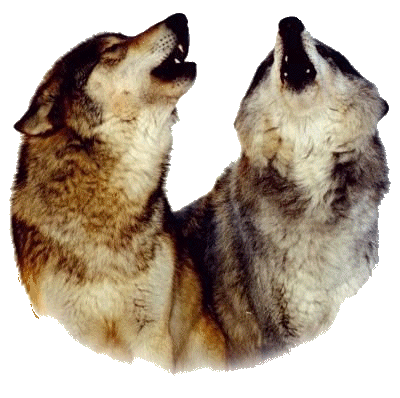
Šung'manitu-tanka 0yate
|
|
|
|
|
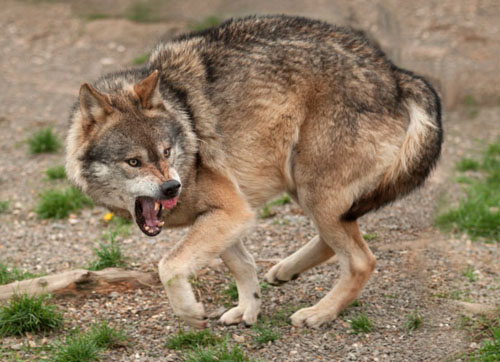
Communication
The wolf's visual signals consist mostly of body language. Just as humans and dogs show their
emotions through various facial expressions, so too does the wolf. This is one reason why a wolf's
mask emphasizes facial features so greatly. Humans smile when they're happy, and our dogs assume a
"happy face" at times. The wolf and dog happy expression includes an open mouth, tongue hanging
loosely, and ears forward. The emotions that are expressed through body language are suspicion,
threat, anxiety, and submission. Threat behavior is quite different. The threatening animal -
dog or wolf - wrinkles its nose, opens its mouth, bares its teeth, pulls its lips forward, and
erects its ears. Usually this expression is accompanied by a growl or a snarl. The anxious dog
or wolf on the receiving end of the threat puts on a very different face. It keeps its mouth
closed and its lips drawn way back, lays back its ears, and whines. One of the most useful
expressions of an alpha wolf is the "fixed stare," or glare. Often, all an alpha has to do is
stare at a subordinate wolf, and that animal will immediately cringe, turn, and slink away. The
glare is an alpha's way of controlling subordinate pack members. A wolf or dog also uses certain
tail and body positions to communicate. For example, a threatening wolf not only snarls and bares
its teeth, but also raises its hackles and tail and essentially inflates its size. Conversely,
the wolf being threatened pulls its lips back in a defensive "grin", lowers itself, holds its
tail between its legs, and may even roll over on its side or back, trying to make itself look
smaller. However, many of us think of communication only as talking or writing to each other.
Those are two good ways to communicate that humans use every day. How do wolves communicate?
Well, even though they can't talk or write, wolves communicate in many ways;

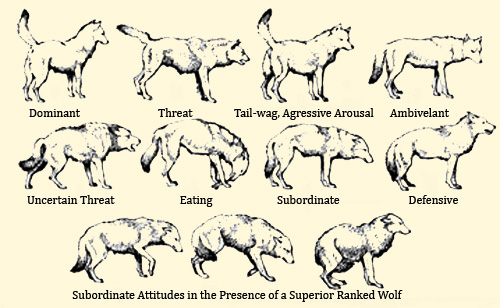
Body Postures
Body language is a tool of communication for the wolf. Just as a human has postures and
gestures that express our intentions, and feelings the wolf also uses body language to communicate. This
ranges from subtle signals-such as a slight shift in weight-to the obvious, like rolling on the back as
a sign of submission.
Dominant postures may include a partly erect tail, walking with the head held high and their eyes
will be directed straight towards other wolves. They may also show raised hackles, they may also
side-swipe or slam into the subordinate members of the pack. They may also growl, showed bared
teeth, a wrinkled forehead, and their ears may stand up.
The dominant animals usually are first to eat at a kill, will urinate standing up with a raised
leg. They will also be the first to attack in encounters with other packs or predators. Sometimes
they may "ride-up" on a subordinate. To "Ride-Up" is to place the forelegs across the shoulders
of a subordinate.
Subordinate postures include lowered tails, a lowered body position, an exposed throat, small
steps towards more dominant members, a peeling back of lips, ears folded back and they will
urinate crouching or even on themselves. They may also raise a hind leg to expose the groin area.

Here are some other examples of Body postures:
Dominance - A dominant wolf stands stiff legged and tall. The ears are erect
and forward, and the hackles bristle slightly. Often the tail is held vertical and curled toward
the back. This display shows the wolf's rank to all others in the pack. A dominant lupine may
stare penetratingly at a submissive one, pin it to the ground, "ride up" on its shoulders, or
even stand on its hind legs.
Submission (active) - In active submission, the entire body is lowered, and
the lips and ears are drawn back. Sometimes active submission is accompanied by a rapid thrusting
out of the tongue and lowering of the hindquarters. The tail is placed down, or halfway or fully b
etween the legs, and the muzzle often points up to the more dominant animal. The back may be
partially arched as the submissive wolf humbles itself to its superior. (A more arched back and
more tucked tail indicate a greater level of submission.)
Submission (passive) - Passive submission is more intense than active submission.
The wolf rolls on its back and exposes its vulnerable throat and underside. The paws are drawn
into the body. This is often accompanied by whimpering.
Anger - An angry lupine's ears are erect, and its fur bristles. The lips may
curl up or pull back, and the incisors are displayed. The wolf may also snarl.
Fear - A frightened wolf tries to make its body look small and therefore less
conspicuous. The ears flatten down against the head, and the tail may be tucked between the legs,
as with a submissive wolf. There may also be whimpering or barks of fear, and the wolf may arch
its back. Defensive - A defensive wolf flattens its ears against its head.
Aggression - An aggressive wolf snarls and its fur bristles. The wolf may crouch,
ready to attack if necessary.
Suspicion - Pulling back of the ears shows a lupine is suspicious. In addition,
the wolf narrows its eyes. The tail of a wolf that senses danger points straight out, parallel
to the ground.
Relaxedness - A relaxed wolf's tail points straight down, and the wolf may rest
sphinxlike or on its side. The wolf's tail may also wag. The further down the tail droops, the
more relaxed the wolf is. Tension - An aroused wolf's tail points straight out, and the wolf may
crouch as if ready to spring.
Happiness - As dogs do, a lupine may wag its tail if it is in a joyful mood.
The tongue may loll out of the mouth.
Hunting - A wolf that is hunting is tensed, and therefore the tail is horizontal
and straight.
Playfulness - A playful lupine holds its tail high and wags it. The wolf may frolic
and dance around, or bow by placing the front of its body down to the ground, while holding the rear
high, sometimes wagged. This is reminiscent of the playful behavior executed in domestic dogs.
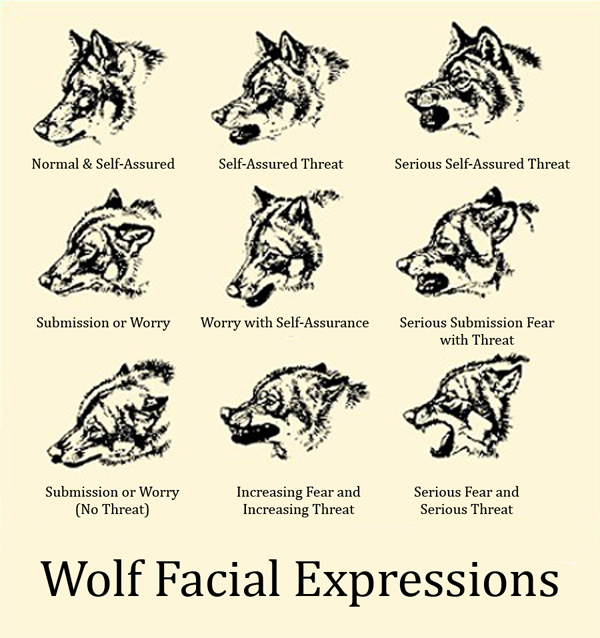
Play is a major part in the lives of the wolf. Wolf pups learn skills that will help them
throughout their lives with hunting, and communication skills. Hierarchy within the litter can
also be determined through play. The more the wolf pups play the stronger they become. There are
many reasons for play within the wolf pack, one of the most apparent reasons for play: fun.
The wolf, like other canines, signal play with the gesture knows as the "play bow". The wolf drops
into a crouching position, wagging tail and a slight but apparent grin on the face. Wolves seems to
enjoy play very much. Often engaging in games of tag, chase and wrestling matches with other pack mates.
<

Communication through Scent
Canines have more olfactory receptors than humans. The olfactory receptors are
organs located in the nose that are responsible for smell. A wolf uses smell to locate members
of the pack, food, and intruders. Research has shown that wolves can detect smells up to 3
kilometers. Wolves also use their sense of smell as a means of communication. Wolves mark their
territory with feces and urine, when wolves enter a territory that is not their own they can smell
the "scent markings". This tells them that the area is already taken by another wolf.
Communication through Sound: The wolf howl
One of the ways wolves communicate is with their voices. There is no sound that I know that
compares with the beauty and strength of a howling wolf. There are many theories as to why a
wolf howls. Wolves can howl at any time of the day not just at a full moon. Although it is believed
that a pack may be more active during the full moon because of the additional light.
Howling serves many purposes but no one knows all of the reasons a wolf howls. A single wolf
howling can sound like 3 or more wolves howling. Howls can change in length and seldom a wolf
stays on the same note while howling, this gives the howl a harmonic effect also called "shift pitch".
A group howl usually starts with a few sharp barks, followed by a low howl that gets louder as
the other wolves join in. Wolves also bark to warn other pack members of danger or to challenge
an enemy. They often growl in dominance disputes or other kinds of "fights." They make a squeaking
noise to call the pups, and the pups' mother will whimper to calm them down. A howl may range from
half-second in duration to about eleven seconds. Depending on the weather conditions the howl of
a wolf can be heard up to 10 miles away.
Some other reasons a wolf may howl:
To notify other pack members of their location. To inform other packs of where they are and their own territory. For the attraction of a mate. To reassemble a scattered pack. To get a pack riled up before a hunt When disturbed When stressed (most often by wolf pups) At the presence of an intruder After playing or other social events After waking up To call for help

|
|
|


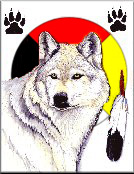

|
|













